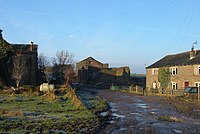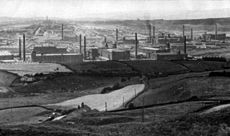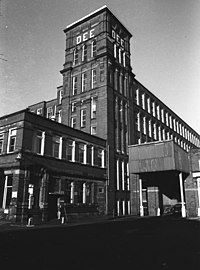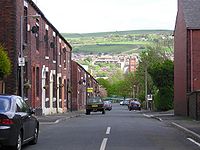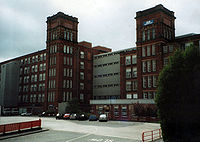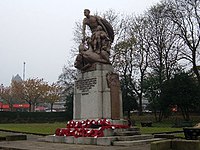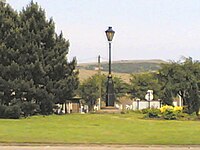Shaw and Crompton
| Shaw and Crompton | |
| Lancashire | |
|---|---|
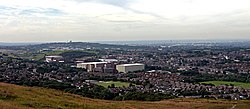 Shaw and Crompton from Crompton Moor | |
| Location | |
| Grid reference: | SD938090 |
| Location: | 53°34’37"N, 2°5’31"W |
| Data | |
| Population: | 21,721 (2001) |
| Post town: | Oldham |
| Postcode: | OL2 |
| Dialling code: | 01706 |
| Local Government | |
| Council: | Oldham |
| Parliamentary constituency: |
Oldham East and Saddleworth |
Shaw and Crompton is a town in southern Lancashire, found some 2 miles north of Oldham and 3½ miles southeast of Rochdale, in the foothills of the southern Pennines. It stands on the River Beal.
Contents
Name
The town bears the twin names of Shaw and Crompton. And there seems no division today between any part named "Crompton" and any named "Shaw". The town's double-barrelled name has been said to make it "distinctive, if not unique".[1] Locally there is a difference of opinion between those who prefer "Shaw and Crompton" and those for "Crompton and Shaw"; a point of contention and confusion.[1][2]
The Ordnance Survey maps the whole town as Shaw, which is a common enough local usage, though various hamlets and localities named "Crompton" stand to each side.
Crompton was the original name for the locality, while Shaw was originally a hamlet in the township of Crompton. Shaw later grew to dominate the locality, winning preference as the name for the whole area.[3] Shaw appears to have originated as the commercial and ecclesiastical centre of Crompton; a small chapel stood there dating back to the 16th century.[4]
The name Shaw is derived from the Old English word sceaga, meaning "wood". The name Crompton is also of Old English derivation, from the words crom or crumb, meaning "bent" or "crooked"; thus "Crooked Village". A local historian stated that "this name aptly describes the appearance of the place, with its uneven surface, its numerous mounds and hills, as though it had been crumpled up to form these ridges".[5] The University of Nottingham's Institute for Name-Studies has offered the suggestion that the name Crompton means "river-bend settlement",[6] which may reflect Crompton's location on a meander of the River Beal.
History
Crompton and its surroundings have provided evidence of ancient British and early English activity in the area. During the Middle Ages, Crompton formed a small township of scattered woods, farmsteads, moorland, and swamp with a small and close community of families.[4][7] The local lordship was weak or absent, and so Crompton failed to emerge as a manor with its own lord and court. Farming was the main industry of this broadly independent and self-supporting rural area, with locals supplementing their incomes by hand-loom woollen weaving in the domestic system.
The introduction of textile manufacture during the Industrial Revolution initiated a process of rapid and unplanned urbanisation. A building boom began in Crompton during the mid-19th century, when suitable land for factories in Oldham was becoming scarce. By the late-19th century Crompton had emerged as a densely populated mill town. Forty-eight cotton mills, some of the largest in the United Kingdom, have been recorded as existing in the area. At the height of its spinning days, as a result of an interwar economic boom associated with the textile industry, Shaw and Crompton was reported to have had more millionaires per capita than any other town in the world. Imports of foreign cotton goods began the decline in the region's textile industry during the mid-20th century; Shaw and Crompton's last mill closed in 1989.
Today, Shaw and Crompton, which covers 4½ square miles and is a predominantly residential area of mixed affluence with a population of 21,721. The legacy of its industrial past can be seen in its six surviving cotton mills, all of which are home to large distribution companies, among them Shop Direct Group's Shaw National Distribution Centre, a major employer in the area.
History
Early history
An early type of axe known as a palstave has been discovered on Crompton Moor, providing evidence of Bronze Age activity.[8] An ancient track, perhaps of Roman origin, crosses the modern Buckstones Road leading to Castleshaw Roman fort in nearby Saddleworth, across in Yorkshire.[9]
Early Middle Ages
In 616 King Æthelfrith of Bernicia crossed the Pennines with an army and passed through Manchester to defeat the Britons at the Battle of Chester.[9] A wave of English colonists followed this military conquest and their settlements are identified by the Old English suffix ton in local place names.[9], suggesting that Crompton as a village could date from the 7th century.[9] The place-names of Crompton and its area are English, suggesting barely any Norse settlement in these parts in the Viking Age.
Following the Norman conquest of England, Crompton was part of a vast estate given to Roger the Poitevin, the maternal nephew of William the Conqueror.[5] It was unmentioned in the Domesday Book of 1086; the first recorded use of the name Crompton for the township was discovered in legal documents relating to Cockersand Abbey near Lancaster, dating from the early 13th century. The document outlines that Gilbert de Notton, a Norman who had acquired the land from Roger de Montbegon, granted his estate to Cockersand Abbey.[10] The Knights Hospitaller and Whalley Abbey held small estates in the township. In 1234, about 80 acres of land at Whitfield in Crompton were given to the Hospitallers.[11] A mediæval cross has been discovered in the ruins of a house at Whitfield.[12]
During the High Middle Ages, Crompton was a collection of scattered woods, farmsteads, moorland, swamp and a single corn mill, occupied by a small and close community of families.[4][7] The area was thinly populated and consisted of several dispersed hamlets, including Whitfield, High Crompton, Cowlishaw, Birshaw and Bovebeale (above Beal).[13] These hamlets were situated above the water-logged valley bottoms and below the exposed high moors.[13] Owing to complicated local arrangements of land tenure, inheritance, and absentee landlords, the local lordship was weak, and Crompton failed to emerge as a manor with its own governing lord and court.[14] This slowly facilitated comparative freedoms and independence for the early people of Crompton,[14] which encouraged the influx of families from the neighbouring Rochdale, including the Buckleys, Cleggs, Greaves and Milnes.[14]
During the Late Middle Ages, the Buckley and Crompton families were recorded as the largest landowners in Crompton, owning land and farmsteads at Whitfield and Crompton Fold respectively.[15] The Crompton family has a well-documented history and can be traced back to the time of Magna Carta, appearing in the Assize Roll for 1245.[16] Crompton is indigenous to the township, and first appears as a family name in the 13th century, when the locality's principal landowner, Hugh de la Legh, changed his family name to "de Crompton" (of Crompton), to reflect the estate he possessed. The family owned a large historic house by the name of Crompton Hall, on the site of Crompton Fold. Crompton Hall first appears in historical records as early as 1442, owned by Thomas de Crompton and his family.[15] The original "mediæval" Crompton Hall was demolished around 1848.[15] A second Crompton Hall, set in its own prominent forested grounds, was erected by the family—by then an influential and affluent investor in the local cotton industry—but following the death of the last remaining family members, the site was sold and, in 1950, the house was demolished to make way for an exclusive development of bungalows.[15]
Because of the poor soils and rugged terrain, Samuel Lewis was able to observe that Crompton's inhabitants were "a race of hardy and laborious men".[17] They have also been described as having a reputation for being a "hardy, frugal and somewhat independent breed",[2] which has been attributed to the tradition of absentee landlords and self-sustenance in earlier times.[14]
The growth of Shaw
Shaw was originally a hamlet of Crompton, but as the commercial centre and the site of the village chapel it grew, eclipsing Whitfield, which had been Crompton's largest village.[4]
There had been a chapel of ease at the hamlet of Shaw since at least the early 16th century, but, due to ecclesiastical arrangements for the parish of Prestwich-cum-Oldham, the inhabitants were obliged to contribute money towards Oldham Parish Church, which in turn had obligation to the mother Church of St Mary the Virgin at Prestwich.[2] On several occasions during the 15th and 16th centuries, the Archdeacon of Chester had to intervene because Crompton's inhabitants refused to contribute towards holy bread and candles used at Prestwich.[2] In 1826, a poll was taken regarding the re-building of Oldham Church. Not one person in Crompton voted in favour of the rebuilding and when a rate was levied to raise money for the new church at Oldham, the people of Crompton refused to pay.[2]
In 1872, Shaw was noted as one of three villages in Crompton.[17] However, due to Shaw's urbanisation following the construction of a major road from Werneth to Littleborough, and the establishment of a post office sub-district named and situated in Shaw, it came to dominate Crompton.[18] Additionally, a separate ecclesiastical parish was created for the township in 1835, which was given the name Shaw because of the church's location on Shaw Moor, in Crompton.[19] The names merged to form the present day Shaw and Crompton, which boundary markers have used since at least the 1950s.[1]
Textiles and the Industrial Revolution
The manufacture of textiles in Crompton can be traced back to 1474, when a lease dated from that year outlines that the occupant of Crompton Park had spinning wheels, cards and looms, all of which suggest that cloth was being produced in large quantities.[20] The upland geography of the area constrained the output of crop growing, and so prior to industrialisation the area was used for grazing sheep, which provided the raw material for a local woollen weaving trade. Wills and inventories from the 15th and 16th centuries suggest most families were involved with small scale pasture, but supplemented their incomes by weaving woollens in the domestic system, and selling cloth, linen and fustians to travelling chapmen for the markets in Manchester and Rochdale.[20]
Despite its remoteness by the Pennines, by the Early Modern period the domestic system in Crompton had produced relatively wealthy inhabitants.[21] The most affluent were those involved in cloth and linen, and their wealth was comparable to that of the merchants of Manchester and Salford.[21]
Until the mid-18th century, Crompton's textile sector had been closely linked with that of Rochdale and Saddleworth in the north and east; it was a woollen manufacturing district. However, as the demand for cotton goods increased, Crompton mirrored developments in Oldham and Manchester in the south and southwest, importing raw cotton and making cotton cloth.[22] To ensure that the woollen trade was kept buoyant, a law existed from 1675 to 1814 to encourage Shaw and Crompton's wool manufacture. It required that the deceased were to be buried in woollen garments.[23]
In the second half of the 18th century, the technology of cotton-spinning machinery improved, and the need for larger buildings to house bigger, better and more efficient equipment became apparent. The profitability of cotton spinning meant that open land that had been used for farming since antiquity, was utilised for purpose-built weavers' cottages.[22] Larger buildings were still desired, and construction of two water powered cotton factories (two or three times the size of a cottage) can be traced to 1782. The construction of more mills followed—ten by 1789—facilitating a process of urbanisation and socioeconomic transformation in the region; the population moved away from farming, adopting employment in the factory system.[24] The introduction of the factory system led to an increase of the township's population; from 872 in 1714 to 3,500 in 1801, mostly as a result of an influx of people from Yorkshire and Lancashire looking for employment in the cotton mills.[24]
Power looms introduced in the early 19th century put an end to the last remnants of the domestic system in Crompton, but not without resistance. Weavers and spinners were paid according to the amount of cloth they produced; independent hand loom weavers saw a drop in their income, and could not compete with the mechanisation of industry that was gathering pace in the township.[25] Luddites rioted in the township in 1826, smashing 24 power looms at Clegg's mill at High Crompton in protest against their worsening standard of living.[25]
Crompton's damp climate provided the ideal conditions for cotton spinning to be carried out without the cotton drying and breaking, and newly developed 19th-century mechanisation optimised cotton spinning for mass industrial manufacture for the global market. When suitable land in nearby Oldham (then the largest and most mill town in the world and with the greatest output)[26] had become scarce in the 1860s, there was a mill building boom in Shaw and Crompton, giving rise to the area as major mill town.[27] The local townscape became dominated by distinctive rectangular brick-built mills, and its former villages and hamlets agglomerated as a single town around these factories.[28] Shaw and Crompton railway station and a goods yard was opened in 1863, allowing improved transportation of textile goods and raw materials to and from the township.[29] Neighbouring Royton had begun to encroach upon southern boundary, forming a continuous urban cotton-spinning district with Oldham, Lees and Chadderton which was responsible for 13% of the world's cotton manufacture.[30]
The demand for cheap cotton goods from this area prompted the flotation of cotton spinning companies; the investment was followed by the construction of 12 new cotton mills from 1870 and 1900.[31] In the post-war economic boom of 1919–20, investors did not have the time to build new mills and so were prepared to pay vastly inflated sums for shares in existing companies. Many mills were refloated at valuations of up to £500,000, or five times what they had cost to build before the war,[4] resulting in the town being nicknamed "The Golden City" as the scramble for shares intensified.[4] Because of this highly profitable share dealing, it was reported in the national press that Shaw and Crompton had more millionaires per capita than any other town in the world.[27][32][33] The number of cotton mills in the township peaked at 36 in 1920.[33]
Supplies of raw cotton from the United States were cut during the American Civil War, which caused the Lancashire Cotton Famine of 1861–1865. In response, the Crompton Local Board of Health was created in 1863, whose purpose was to ensure social security and maintain hygiene and sanitation in the locality.[34] The Great Depression, and First and Second World Wars each contributed to periods of economic decline in Shaw and Crompton. Although the industry endured, as imports of cheaper foreign yarns increased during the mid-20th century, Shaw and Crompton's textile sector declined gradually to a halt; said to have over-relied upon the textile sector,[35] cotton spinning reduced in the 1960s and 1970s, and by the early 1980s only four mills were operational.[36] In spite of efforts to increase the efficiency and competitiveness of its output, the final cotton was spun in Shaw and Crompton in 1989, in Lilac and Park mills.[18] Of the 48 cotton mills that have occupied Shaw and Crompton, only six are still standing, all of which are now used as distribution centres.
Post-industrial history
Since deindustrialisation, Shaw and Crompton's population has continued to grow as a result of intensive housing expansion and redevelopment which has modernised much of its former Victorian and Edwardian terraced housing districts. The town has 9,274 residential dwellings, of which one third are Victorian or Edwardian terraces, built for the cotton mill workers of former times. It is considered a popular residential area of relative prosperity,[37] with a variety of housing types.[38] The Buckstones and Rushcroft areas contain modern housing estates and are amongst the most affluent suburbs of the town. They were built as part of an agreement made in the 1950s between the then Crompton Urban District and the County Borough of Oldham councils, to alleviate Oldham's chronic shortage of quality housing.[39] The town has subsequently been described as having "good community spirit and relative prosperity, which, in turn, create popular residential areas".[38]
Shaw and Crompton has been used as a filming location for domestic films and television programmes, including The Parole Officer, Common As Muck, Scott & Bailey[40] and The Fred Dibnah Story, the latter of which documented Fred Dibnah's demolition of the [Briar and Cape mill chimneys.[41]
Churches
The township of Crompton was originally within the parish of Prestwich-cum-Oldham in the Diocese of Lichfield, until 1541, during the Reformation, when the diocese was divided and Crompton became part of the Diocese of Chester. This in turn was divided in 1847, when the present Diocese of Manchester was created.[42]
The exact date of the establishment of a place of worship in Crompton is uncertain. Although Shaw Chapel is certain to have been in existence since the early 16th century, it has been put that "Shaw Chapel is even more ancient than Oldham Old Church". Shaw Chapel was anciently known as St Patrick's Chapel-on-the-Moor, and during the reign of James I of England, "it was situate in the midst of the common called Shaw Moor, not a single habitation being near it".[43] It is thought to have been constructed following an increase in wealth produced by the localisation of the woollen trade during a very bleak period,[43] although, in 1552 it was noted that it had no endowment, and its ornaments were in poor condition.[44] It was rebuilt in 1739 and enlarged in 1798, and rebuilt again in 1870. It is now known as the Church of Holy Trinity.[44]
Shaw and Crompton has three Church of England parishes: Shaw, High Crompton, and East Crompton.[19] In addition, a variety of non-conformist denominations are represented in the town. Presbyterian ministers were recorded preaching at Shaw Chapel in as early as the 1650s.[45] The Religious Society of Friends held conventicles in Whitfield in 1660s and 1670s.[45]
- Church of England:
- St James, East Crompton (1847)
- St Saviours Crompton Fold (1908)
- Holy Trinity, Shaw (1871)
- St Mary's High Crompton (1872)
- Methodist:
- Shore Edge Methodist (1873)
- St Andrew's
- St Paul's Shaw Methodist (1863)
- Salvation Army Church (1896)
- United Reformed Church: Shaw United Reformed Church (1885)
- Roman Catholic: St Joseph
Most of the above churches participate in Shaw's annual Whit Walks event at Whitsum, when congregations, choirs, and brass bands parade through the streets from their respective churches before taking part in one large, communal, inter-church service.
Lie of the land
Shaw and Crompton lies in the very east of Lancashire, by the border with the West Riding of Yorkshire, across which border are Saddleworth and the Pennines. The great towns of Rochdale and Oldham lie to the northwest and south respectively of Shaw while Royton is a mile west.
A heavy rail line bisects the town from north to south.
Samuel Lewis, in his A Topographical Dictionary of England (1848) wrote of Compton as being in "a bleak situation",[17]
The town of Shaw and Crompton lies in the valley of the River Beal, which runs northward through the town towards the village of Newhey. The land to the east of the town steadily rises, reaching a height of 1,283 feet at the summit of Crompton Moor. To the west, the land reaches around 699 feet at High Crompton and 825 feet at Whitfield, and from these highpoints the surface slopes away in all directions.[13]
The River Irk rises on Shaw and Crompton's western boundary with Royton.[46]
The geology hereabouts is represented by carboniferous coal measures.[13] The soils of the town are broadly sterile,[17] the poorest being in the upland moors.[13]
Shaw's and Crompton's built environment is similar to the urban structure of most British towns; residential dwellings centred around a High Street in the town centre, which is the local centre of commerce. There is a mixture of low-density urban areas, suburbs, semi-rural and rural locations in Shaw and Crompton, but overwhelmingly the land use in the town is residential; industrial areas and terraced houses give way to suburbs and rural greenery as the land rises out of the town.[47] Generally, property in the centre, west, and south of the town is older and smaller in comparison to that found in the east and north.
Economy
From the 18th century onwards, Shaw and Crompton's economy was closely tied with that of Britain's textile manufacture, particularly the cotton spinning sector.[48] No longer is it so.
Shaw and Crompton has become a base for distribution companies as a result of the town's good transport links, its supply of large, disused mill properties, and its situation between the major towns of southern Lancashire and those of the West Riding of Yorkshire. The Shaw National Distribution Centre, one of Europe's largest warehouse distribution centres,[49] and a major employer of the local and wider community. The company occupies three former cotton mills and state-of-the-art purpose-built storage and sorting facilities on a 20-acre complex within the town. In 2007, the site became the retail company's only packing and distribution centre for non-bulk items. It employs nearly 1,000 staff. Several other major national chains have distribution centres in the town.
Warburtons has had one of its 11 major bakeries in Shaw and Crompton since 1965. The "Pennine" bakery produces around 500,000 loaves a week and distributes them to major multiples and independent retailers throughout Lancashire, Cheshire, and Derbyshire. The bakery on Glebe Street employs around 200 staff and produces a wide range of Warburtons bread range.[50]
Trent Mill Industrial Estate, on the edge of the town near Rushcroft, takes its name from the mill that was once there. The business park is home to several small industrial companies. It was partially destroyed by a fire that started in a plastics factory in the early hours of 28 April 2007.[51][52]
On 6 August 2007, a 35,000 square-foot supermarket opened on the site of the former Dawn Mill.[53] A derelict row of houses on Eastway was demolished as part of this development. Two houses on Greenfield Lane were also demolished, allowing an existing rival store to expand to compete. The supermarket (an ASDA) cost £20 million to construct, and is the first ASDA store in the United Kingdom to use environmentally friendly construction techniques. It incorporates a "sustainable" timber frame and an energy-saving ventilation system, which together have eradicated the need for 500 tons of steel and 450 tons' worth of carbon emissions.[53]
Sights about the town
War memorials
The main Crompton War Memorial, located on the High Street, consists of a granite plinth surmounted by a large bronze statue flanked by two Rolls of Honour containing the 346 names of those from Shaw and Crompton who fought and died in First World War. Panels listing the Roll of Honour from Second World War were added and unveiled on 12 November 1950 by Councillor H M Turner:
The symbolic memorial depicts a group in which the central figure is a man defending the future generations, represented by young children, against foreign aggression, represented by a beast. The memorial is also a time capsule. Inside it is a lead casket containing coins, a copy of the local newspaper, three cops of spun cotton, and a length of cloth manufactured in the local area.[54]
A second, smaller war memorial is located in Jubilee Gardens, dedicated to the soldiers who fought in the Second Boer War. It consists of a plaque built into a stone wall that is located between two large bushes:
In 1995, to mark the 50th anniversary of the ending of the Second World War, a landmark known as The Shaw and Crompton Beacon was erected in Jubilee Gardens:
erected by the Parish Council in 1995 to
commemorate the fiftieth anniversary of
the ending of World War Two
this plaque was presented by members of the British Legion
Crompton Moor
Spanning approximately 160 acres, and reaching an elevation of 1,282 feet, Crompton Moor is a registered common and, since 2003, a designated Site of Biological Importance.
Brushes Clough and Pingot are former coal and sandstone quarries on Crompton Moor. During the 1970s, quarrying was halted, the land was reclaimed, and thousands of pine trees were planted. The area has since been used for recreation, including hiking, orienteering, and mountain biking. Brushes Clough Reservoir was constructed in the 19th century by the local council,[55] using stone quarried from this site. The area is now managed by United Utilities.
Since the 1960s an unnamed waterfall (provisionally called Crompton Waterfall) cascades off Crompton Moor into the now unused Pingot Quarry forming the Old Brook, a tributary of the River Beal.
Big Lamp
The Big Lamp was a six-sided gas-powered public street lamp standing 20 feet high at the original cross-road junction of Manchester Road, Oldham Road, High Street, and Church Road. It was pulled down on 17 June 1925, when electric lighting was introduced.[56] During the 1990s, the junction was redeveloped to accommodate the new Crompton Way bypass. A large roundabout was built, and a scaled-down replica of the original Big Lamp was erected in its centre. The new Big Lamp is electrically powered and stands only about 6 feet high.[56]
Parks and markets
There are three main public parks in Shaw and Crompton:
- Dunwood Park alongside the Oldham Loop Railway Line. The land that forms Dunwood Park was presented to Crompton Urban District Council by Captain Abram Crompton JP on the 22 June 1911, and opened as a park by him on the 14 September 1912.
- High Crompton Park is in High Crompton
- Jubilee Gardens are in Shaw and Crompton town centre, behind the Crompton War Memorial.
Shaw and Crompton has large areas of land reserved for sporting and communal events; these are located off George Street, Edward Road, and Rushcroft Road respectively.
Shaw Market, located on Westway, is open to market retailers and customers every Thursday. At other times most of the market area becomes a public car park. The market area has been used occasionally for fun fairs and other events. Shaw and Crompton town has several public sporting establishments. Crompton Pool is a swimming pool built in 1899 on Farrow Street in the town centre,
Crompton Cricket Club has it home on Glebe Street.
Outside links
| ("Wikimedia Commons" has material about Shaw and Crompton) |
- Genuki.org, information about Crompton at GENUKI
- Crompton: from the Normans to the Tudors Historical reference
- www.ShawLive.tv, Local internet TV service, Community information and webcams
- www.shawcam.co.uk, Website featuring picture gallery, discussion boards, and live video feed of Shaw and Crompton.
- www.shawlife.co.uk, Message board with picture galleries and articles contributed by local residents.
- www.dunwoodpark.co.uk, Home page of local park
References
- ↑ 1.0 1.1 1.2 Crompton Urban District Council 1959, p. 69.
- ↑ 2.0 2.1 2.2 2.3 2.4 "An ancient township called Crompton ...", Oldham Evening Chronicle: 8, 29 February 2008
- ↑ Hanyes 2004
- ↑ 4.0 4.1 4.2 4.3 4.4 4.5 Hunt & Stott 1988
- ↑ 5.0 5.1 Allen 1985, p. 1.
- ↑ University of Nottingham, Crompton, nottingham.ac.uk, http://www.nottingham.ac.uk/english/ins/kepn/detailpop.php?placeno=12892. Retrieved on 15 February 2008.
- ↑ 7.0 7.1 Ballard 1986, p. 28.
- ↑ Monument no 46038, Pastscape.org.uk, http://www.pastscape.org.uk/hob.aspx?hob_id=46038. Retrieved on 1 August 2008.
- ↑ 9.0 9.1 9.2 9.3 Ballard 1986, pp. 11–12.
- ↑ Ballard 1986, p. 13.
- ↑ Ballard 1986, p. 14.
- ↑ Monument no 46074, Pastscape.org.uk, http://www.pastscape.org.uk/hob.aspx?hob_id=46074. Retrieved on 1 August 2008.
- ↑ 13.0 13.1 13.2 13.3 13.4 Rathbone 2000, p. 143.
- ↑ 14.0 14.1 14.2 14.3 Ballard 1986, p. 17.
- ↑ 15.0 15.1 15.2 15.3 Ballard 1986, p. 19.
- ↑ Magee 1988, p. 3.
- ↑ 17.0 17.1 17.2 17.3 Lewis 1848, pp. 729–733.
- ↑ 18.0 18.1 Oldham Borough Official Guide; The Borough's Districts, British-publishing.com, http://www.british-publishing.com/Pages/OldhamOG/districts.html. Retrieved on 3 April 2007.
- ↑ 19.0 19.1 Ballard 1986, p. 53.
- ↑ 20.0 20.1 Ballard 1986, p. 66.
- ↑ 21.0 21.1 Rathbone 2000, pp. 146–147.
- ↑ 22.0 22.1 Ballard 1986, p. 67.
- ↑ Heritage; The Oldham Boroughs; Crompton, visitoldham.co.uk, archived from the original on December 21, 2005, http://web.archive.org/web/20051221140913/http://www.visitoldham.co.uk/heritage/crompton.htm. Retrieved on 22 June 2006.
- ↑ 24.0 24.1 Ballard 1986, p. 68.
- ↑ 25.0 25.1 Ballard 1986, p. 69.
- ↑ Gurr & Hunt 1998, pp. 4–5.
- ↑ 27.0 27.1 Aspin 1981, p. 18.
- ↑ Sellers 1991, p. 47.
- ↑ Stott 1996, p. 56.
- ↑ Heritage; The History of Oldham; Oldham History, visitoldham.co.uk, archived from the original on June 4, 2008, http://web.archive.org/web/20080604082253/http://www.visitoldham.co.uk/heritage/history.htm, retrieved 2008-07-26
- ↑ Ballard 1986, p. 71.
- ↑ Stott 1996, p. 8.
- ↑ 33.0 33.1 Manchester City Council, Oldham Towns; Shaw, spinningtheweb.org.uk, http://www.spinningtheweb.org.uk/a_display.php?irn=239&QueryPage=&lang=, retrieved 2006-12-07
- ↑ Ballard 1986, p. 73.
- ↑ Crompton Urban District Council 1959, p. 71.
- ↑ Ballard 1986, p. 72.
- ↑ Greater Manchester Police (2006-01-01), Description of Royton & Shaw, gmp.police.uk, archived from the original on 2007-11-03, http://web.archive.org/web/20071103214049/http://www.gmp.police.uk/division12/pages/royton.htm, retrieved 2006-12-15
- ↑ 38.0 38.1 Homesearch (2003-05-21), Spotlight on Shaw, Oldham, manchesteronline.co.uk, archived from the original on March 7, 2007, http://web.archive.org/web/20070307114134/http://www.manchesteronline.co.uk/homesearch/latest/whereyoulive/s/59/59014_spotlight_on_shaw_oldham.html, retrieved 2007-04-03
- ↑ Crompton Urban District 1959, p. 13.
- ↑ "Chronicle helps our Suranne crack crime|". Oldham Evening Chronicle. oldham-chronicle.co.uk. 2011-03-04. http://www.oldham-chronicle.co.uk/news-features/8/news-headlines/53539/chronicle-helps-our-suranne-crack-crime. Retrieved 2011-05-29.
- ↑ The Fred Dibnah Story, Shaw and Crompton, 1986
- ↑ Allen 1985, p. 7.
- ↑ 43.0 43.1 Allen 1985, p. 3.
- ↑ 44.0 44.1 Monument no 45900, Pastscape.org.uk, http://www.pastscape.org.uk/hob.aspx?hob_id=45900, retrieved 2008-07-24
- ↑ 45.0 45.1 Stott 1986, p. 55.
- ↑ Brownbill & Farrer 1911, pp. 108–112.
- ↑ "Many faces of Shaw", Oldham Evening Chronicle: 22, 2008-05-07
- ↑ Crompton Urban District Council 1959, p. 15.
- ↑ Bowers, Simon (2009-02-02). "Woolworths lives again as online brand". guardian.co.uk. http://www.guardian.co.uk/business/2009/feb/02/woolworths-online-shop-direct. Retrieved 2009-02-02.
- ↑ Warburtons Bakeries; North West; Pennine, Warburtons Virtual Press Office, archived from the original on June 9, 2005, http://web.archive.org/web/20050609090131/http://www.warburtons.presscentre.com/Content/Detail.asp?ReleaseID=110254&NewsAreaID=111, retrieved 2007-04-03
- ↑ Firefighters tackle factory blaze, BBC News, 2007-04-28, http://news.bbc.co.uk/1/hi/england/manchester/6602739.stm, retrieved 2007-04-28
- ↑ Hooton, Richard and Torr, Martyn (2007-04-30), Inferno wrecks plastics factory, Oldham Evening Chronicle, http://www.oldham-chronicle.co.uk/NEWSM03.html, retrieved 2007-04-30
- ↑ 53.0 53.1 "Green store shooting up", Oldham Evening Chronicle: 25, 2007-04-24
- ↑ Stott 1996, p. 16.
- ↑ Crompton Urban District 1959, p. 19.
- ↑ 56.0 56.1 Stott 1996, p. 14.
Books
- Allen, George (1907), Shaw Church in By-gone Days, York: Coultas & Volans
- Aspin, Chris (1981), The Cotton Industry, Shire, ISBN 0-85263-545-1
- Ballard, Elsie (1986), A Chronicle of Crompton (2nd ed.), Royton: Burnage Press, ISBN 5-00-096678-3
- Brownbill, John; Farrer, William (1911), A History of the County of Lancaster: Volume 5, Victoria County History, ISBN 978-0-7129-1055-2
- Crompton Urban District Council (1959), Crompton Urban District: Official Guide and Traders' Directory, Jones & Brooks
- Gurr, Duncan; Hunt, Julian (1998), The Cotton Mills of Oldham, Oldham Education & Leisure, ISBN 0-902809-46-6
- Hanyes, Hannah (2004), Rochdale Photographic Memories, Francis Frith Collection, ISBN 1-85937-846-3
- Hunt, Julian; Stott, Frances (1988), Looking Back at Crompton, Oldham Education & Leisure, ISBN 0-902809-17-2
- Samuel Lewis (publisher) (1848), A Topographical Dictionary of England, Institute of Historical Research, ISBN 978-0-8063-1508-9
- Magee, Rob (1988), A History of Crompton and Shaw Pubs, Neil Richardson, ISBN 1-85216-030-6
- Rathbone, Peter (2000), The Lives of the People of Crompton, Lancashire 1580–1700, Lancashire and Cheshire Antiquarian Society
- Stott, Frances (1996), The Changing Face of Crompton, Oldham Education & Leisure, ISBN 0-902809-38-5
- Sellers, Gladys (1991), Walking the South Pennines, Cicerone Press, ISBN 978-1-85284-041-9
- Wells, Jeffrey (2002), The Oldham Loop part one: Manchester Victoria to Shaw and Crompton, Foxline, ISBN 978-1-870119-68-9
